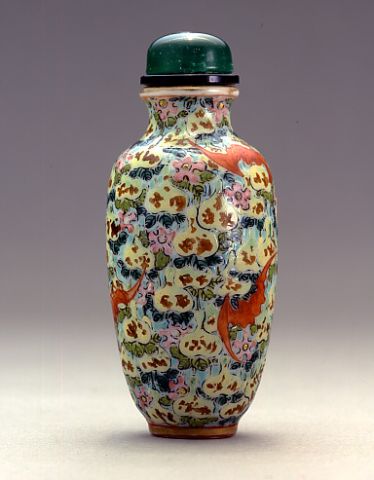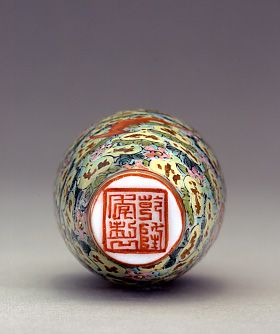

Bottle ID: 00518
ENAMELED FAMILLE ROSE, FRUITING GOURDS W/LEAFY VINES
Date: 1750-1799
Height: 58 mm
Porcelain, hard paste, of cylindrical baluster form, with an everted gilded mouth and slightly concave foot, decorated in famille rose and iron-red enamels and gilded, with a design of fruiting gourds amongst leafy vines and prunus blossom with five bats swooping amongst the foliage; the base with a four character iron-red Qianlong nianzhi mark in seal script and of the period.
Imperial, attributed to the Palace Workshops, Jingde Zhen.
Similar Examples:
Crane Collection no. 471.
Moss, Hugh, Victor Graham and Ka Bo Tsang. The Art of the Chinese Snuff Bottle - The J & J Collection, 1993, Vol. I, pp. 391-393, no. 231.
Kleiner, Robert. Chinese Snuff Bottles in the Collection of Mary and George Bloch, 1995, p. 291, no. 193.
Provenance:
Asian Art Studio
The Monimar Collection
Robert Kleiner and Co.
Christie's, New York, March 23, 1995, lot 176
Exhibited:
Annual Convention ICSBS Toronto, October 2007
In 1674 during the Wu Sangui Rebellion large parts of the kiln complex at Jingde Zhen were destroyed. In 1680 in Beijing the Kangxi Emperor was instrumental in setting up the Imperial Palace Workshops, and at the same time he ordered that porcelain pieces should be made for the Palace. Zang Yingxuan was the first Director and Supervisor of the Imperial Kilns at Jingde Zhen and he set about rebuilding the complex. The Imperial Kilns at Jingde Zhen were re-established in a short period of time and between 1681 and 1688 the Record of Ceramic Production at Jingde Zhen states that the porcelain "wares were finely potted with translucent quality and a wide variety of colored glazes....". It is recorded also that snuff bottles were produced during Kangxi's reign of cylindrical miniature bottle form and were termed bi yan ping, rather than bi yan hu. In 1743, the eighth year of Qianlong an imperial order is recorded which is more specific, to make forty porcelain bottles of various forms. There are very few porcelain bottles from this period both of this cylindrical form and covered overall in enamel. The small size and shape of this bottle is found in other materials such as jade and agate, and seems to have been favored by the Imperial workshops in those materials. From the Yongzheng period onwards translucency was an important feature of porcelain objects decorated in the famille rose palette. This may account for one of the reasons that so few Qianlong mark and period bottles were produced in porcelain as it is hard to achieve any translucency with such a small working surface. In the case of this bottle that is clearly not the aim and this bottle seems more akin to the relief molded double gourd-shaped porcelain bottles than any other group.
< Back to full list
 English
English 中文
中文